About Me

- Fabian
- 29 year-old Chemical Seed Operator Fabian from Swift Current, has many pursuits including meditation and watching sporting events. Has travelled ever since childhood and has visited numerous places, including Historic Bridgetown and its Garrison.
Powered by Blogger.
Blog Archive
-
▼
2016
(95)
-
▼
May
(14)
- Pet Scoop: Injured Dog Walks Into ER for Help, Gos...
- Clarification regarding the New Graduate Starting ...
- Petco to adjust advertising after talks with AVMA
- New regulation requires overtime pay for more empl...
- Pet Scoop: Missing Hiker and Dog Found Safe, Flat ...
- October dates set for 2016 AVMA Economic Summit
- Pet Scoop: Baseball Team Adopts Abandoned Puppy, L...
- Hands-on, state-of-the-art: AVMA's Vet Clinic Live!™
- Search and Rescue Dogs: The Fascinating Ways These...
- Partners for Healthy Pets resource helps you bette...
- New salary calculator tool helps students and rece...
- Tragedy of intangibles: Connecting wellness with e...
- Pet medication hearing: AVMA testimony strives to ...
- AVMA advocates for veterinary licensing in U.S. wa...
-
▼
May
(14)
Saturday, May 28, 2016
May 27, 2016: We've scoured the Web to find the best and most compelling animal stories, videos and photos. And it's all right here.
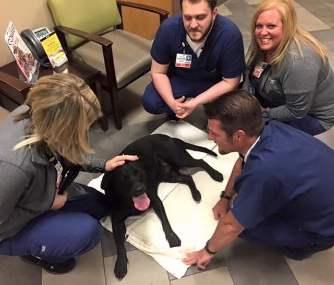
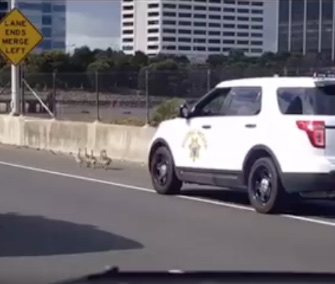
Image: Capone the black Lab

Lost Lab Gets Help at ER
Somehow, a lost black Labrador Retriever knew exactly where to go when he injured his leg - and the staff at Indiana's Community Hospital Anderson quickly stepped up to help him. “He literally walked straight up like he knew he was coming to the right place,” said Dr. Thomas Short. The emergency room doctors checked him out and made him comfortable. Once their shift ended, they took him to an emergency vet, who thought he'd been hit by a car but would recover. In the meantime, the hospital shared a photo of him on Facebook, in the hopes of finding his owner - and it worked. Capone's owner, Nick Karagianis, said the 1-year-old dog got away when he took him for a walk after he got home from work at about 2 a.m. Thursday. When he resumed his search in the morning, he talked to a passerby who said she'd seen a dog meeting Capone's description on Facebook. They were reunited later that day. “Thank you sooooo much to the community hospital team for taking care of my baby boy!!!” Karagianis commented on Facebook. The kind hospital staff even paid Capone's vet bill, on the condition that his owner get him neutered and microchipped. - Read it at Indianapolis' Fox 59Secret Tasmanian Devil Colony Could Help Species
Scientists who found a hidden colony of Tasmanian devils in a remote area say the animals could help save their species by adding diversity to their gene pool. The marsupials have been devastated by the contagious and deadly facial tumor disease. “For us this is massive,” said University of Sydney geneticist Kathy Belov. “For years we have been calling devils clones because there's so little diversity and now we find that there is diversity out there, it's just in remote areas.” The genetic diversity could prove to be a key component to the species' survival. - Read it at the Huffington PostStudy: Harbour Porpoises Eat Constantly
Using tiny computers attached to harbour porpoises by suction cups, researchers in Europe have found the small cetaceans hunt and eat almost constantly because they require a lot of energy to survive. "Our results show that porpoises hunt small fish, typically less than five centimeters, nearly continuously day and night at ultra-high rates, attempting to capture up to 550 fish per hour, and frequently more than ten per minute with a remarkable success rate of more than 90 percent," said Danuta Wisniewska of Aarhus University in Denmark. They also said that anything that might limit the porpoises' ability to feed could put them in serious jeopardy. The study was published in the journal Current Biology. - Read it at Phys.orgImage: Goslings on Interstate

Police Escort Goslings Off Freeway
A flock of baby geese got a special escort as they made their way down California's Interstate 80 on Sunday morning. The California Highway Patrol in Oakland got a call about some goslings who were wandering along the busy roadway. “We ran a traffic break and we stopped the freeway so we can get them corralled to the right hand shoulder - and that's where the world's slowest pursuit took place,” said Officer Sean Wilkenfeld. At least three CHPs vehicles gathered the “felonious fowl,” as Wilkenfeld called them, and guided them toward an exit to get them to the water. CHPs Oakland shared a video of the “nail-biting pursuit” on Facebook. - Watch it at SF GateStudent Surprised to See His Service Dog in Yearbook
When North Guilford High School, North Carolina, student Harry Hulse had his photo taken for the yearbook, the photographer also got a quick portrait of Taffy, his diabetes alert dog. Taffy is always by Harry's side, pawing at him whenever his blood sugar needs an adjustment. Taffy is “basically one of the kids,” said the school's yearbook editor, Stephanie Hicks. So, when she heard his photo had been taken, she thought Taffy “obviously has to be next to Harry in the yearbook, he always is.” The yearbook staff kept the plan a secret so Taffy's placement would be fun a surprise when it was published. Harry was surprised, and touched, by the gesture for his “best friend.” The news comes on the heels of the story of another service dog who appeared in a Louisiana middle school yearbook this year. - See photo at CNN
Friday, May 27, 2016
The AVMA sincerely apologizes for any misunderstandings regarding the gender wage gap resulting from the recent online release of its New Graduate Starting Salary Calculator. Although this calculator was debuted during the March 2016 Student AVMA Symposium to rave reviews, … read more >
Yesterday afternoon, AVMA staff had a very cordial conversation with Petco leadership regarding Petco's new advertising campaign for their grooming services. Petco staff was very understanding and supportive of veterinarians' concerns that anything out of the ordinary discovered during a … read more >
Labor Department offers webinars to explain new rules A new rule finalized last week by the U.S. Department of Labor requires time-and-a-half overtime pay for far more salaried workers than previously have been covered. This rule applies to employees in … read more >
Saturday, May 21, 2016
May 20, 2016: We've scoured the Web to find the best and most compelling animal stories, videos and photos. And it's all right here.
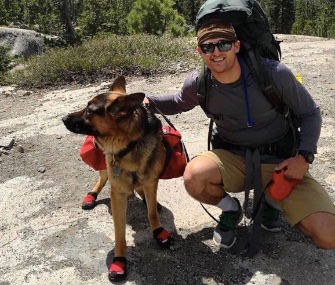
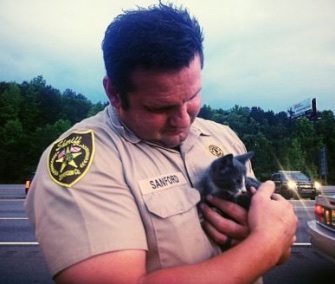
Image: Cody Michael and Bauer

Man and Dog Rescued by Helicopter
On Monday morning, Cody Michael texted his parents a photo of himself and his German Shepherd, Bauer, hiking in the Sierra Nevada wilderness. He said he planned to do some fishing and leave by noon, but when they hadn't heard from them by that night, they got worried. The Placer County, California, Sheriff's Office began a search for Michael, 23, and Bauer that lasted three days. Finally, on Thursday morning, members of the National Guard flying overhead in helicopters spotted Michael's campsite and a makeshift sign he'd made from duct tape reading “HELP.” The recent college graduate and his dog were lifted into the Blackhawk helicopter and brought to a command post, where the two were reunited with their family. Michael had made a wrong turn and walked several miles in the wrong direction, then became disoriented. “It's nothing short of a miracle,” said Dena Erwin, a spokeswoman for the Placer County Sheriff's Office. “To see him reunited with his family, they were so delighted.” - Read it at the Sacramento BeeEndangered Florida Sparrow Chicks Hatch
There are only 150 Florida grasshopper sparrows left in the wild, making it one of North America's most endangered birds. On May 9, the first four captive-bred chicks hatched at the Rare Species Conservatory Foundation in Loxahatchee, Fla. So far, their mom seems to be taking good care of her nestlings. “This breakthrough is great news because the Florida grasshopper sparrow couldn't be more vulnerable,” said Sandra Sneckenberger, one of the U.S. Fish and Wildlife Service's lead biologists on the bird's recovery effort. Storms in Florida have flooded the wild birds' first nest attempts, raising concerns about the 2016 population count. - Read it at Discovery NewsStudy Aims to Help Extend Dogs' Lifespans
Researchers conducting an ongoing dog study at the University of Washington are hoping to understand how and why signs of aging happen - and possibly to help slow them down. In the study's first phase, researcher Matt Kaeberlein has been conducting a clinic trial of the drug rapamycin, which significantly extended the lives of mice. A 10-week trial of it in large-breed, middle-aged pet dogs showed it improved heart function. The next step for the Dog Aging Project will involve studying 10,000 companion dogs to create a public database that could be used by veterinarians and researchers to better understand canine aging. They're hoping what they learn will also help shed light on aging in humans. "Improving our understanding of aging enables us to improve so many other dimension of health care for everyone," said Kate Creevy, of Texas A&M University's College of Veterinary Medicine. - Read it at CBS NewsImage: Alabama sheriff's deputy with kitten

Kitten Found During Tire Change
While helping a driver stranded on Interstate 20 near Leeds, Alabama, Wednesday night, Jefferson County Sheriff's Deputy Sanford wound up rescuing a kitten. “As he worked the jack near the front tire [Sanford] heard a faint cry from the engine compartment of the car. He had the driver open the hood and discovered a small gray and white kitten inside," the sheriff's office said in a press release. The kitten had apparently snuck under the hood before the family left Atlanta - which is about 130 miles from Leeds. Sanford named the stowaway Atlanta and got her food and water before bringing her to the Greater Birmingham Humane Society. She had a few burns but is already healing, the shelter said in a Facebook post on Thursday. - Read it at Alabama's ABC 33/40Haus the Hero Dog Goes Home
There's happy news for Haus, the German Shepherd who protected his family's 7-year-old girl from a rattlesnake in their backyard on May 11. He's finally back home after being treated for a week at Blue Pearl Emergency Veterinary Clinic in Tampa. The 2-year-old dog was bitten three times by the snake and needed a steady drip of antivenin instead of one or two doses, which is the typical amount. Veterinarians also had to treat him for muscle damage in his legs for the severe bites. A crowd of supporters cheered as Haus left the animal hospital Thursday. Today, he'll receive the “Heroic Dog Award” from PETA. - Read it at Tampa's Fox 13
Tuesday, May 17, 2016
If you're interested in the economic future of the veterinary profession-and in gathering information and tools to help you operate your business more successfully-set aside the dates October 24-25 to attend this year's AVMA Economic Summit. Our economics team convenes … read more >
Saturday, May 14, 2016
May 13, 2016: We've scoured the Web to find the best and most compelling animal stories, videos and photos. And it's all right here.
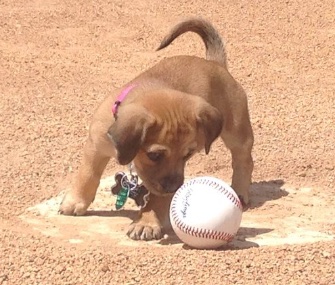
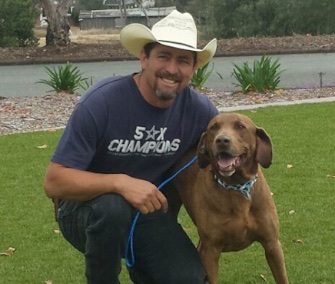
Image: Savannah Bananas puppy

Puppy Found in Stadium Parking Lot
At 7 weeks old, a sweet puppy was found crying in a parking lot at Grayson Stadium in Savannah, Georgia, this week. She was rescued by a staff member of the Savannah Bananas, a collegiate-league baseball team that plays at the park - and she quickly became part of the team. Daisy was adopted by the Bananas' president, Jared Orton, and his wife, and she now goes to work for the team each day. Daisy didn't have any identification, and a veterinary exam found that she was healthy - just hungry and dehydrated. “It was just meant to be that we'd have a team dog as part of our staff,” Orton said. “We aren't sure how big she'll get, so it's hard to say if she'll be able to pick up a bat or just coach first base but as she grows, she'll be a fixture at the ballpark.” - Read it at the Washington PostRare Sumatran Rhino Born
A critically endangered Sumatran rhino gave birth to a female calf at an Indonesian sanctuary early Thursday. It's the second baby for Ratu, whose name means Queen, and the new baby was up walking around and nursing within a few hours. There are only an estimated 100 Sumatran rhinos left in the world, so the birth is considered a major step forward. This is only the fifth time a Sumatran rhino has been born in a breeding facility. The animals have been hunted by poachers for their horns. - Read it from AFP via Yahoo NewsStudy: Climate Change Is Shrinking Shorebird
A new study finds that the red knot shorebird, which is about the size of a robin, is getting even smaller because of arctic warming - and that's making it harder for them to survive. “It's even worse than we thought,” said Michael Reed of Tufts University. “This is going to increase their extinction risk, and the red knots are already in the highest risk category.” They found that warming is contributing to the malnutrition of red knot chicks in the Arctic, which leads to shorter bills and smaller body sizes. Those changes are reducing their survival rates. The study was published in the journal Science. - Read it at National GeographicImage: Brownie and his owner

Lost Lab Reunited With Owner
When he heard his missing Labrador Retriever was found 720 miles away, three years after he was lost, Ricardo Dominguez drove non-stop through the night to be reunited with his pal. Brownie disappeared from Dominguez's New Mexico horse ranch and was found wandering the streets in San Diego last week. When Dominguez got the news that he'd been found, he was working at a job site in El Paso, Texas. Now 7 years old, Brownie clearly remembered his owner when he arrived to pick up him from San Diego County Animal Services. “He looks up through the door at me in my cowboy hat, and his eyes were, wow is that you?” said Dominguez. “His eyes went wide, and he went wild, started dragging the person on the leash, and he came and jumped on me and went crazy!” It's unclear how Brownie wound up in San Diego, but Dominguez is happy to have him back home. - Watch it at NBC San DiegoMother Goose Gets Police Help for Baby
Somehow, when one of her goslings became tangled in the string from a Mother's Day balloon, a mother goose knew how to get her baby help. Cincinnati Police Sgt. James Givens said he was parked in his cruiser on Monday when he heard pecking at the door. “It kept pecking and pecking and normally they don't come near us. And then it walked away, and then it stopped and looked back, so I followed it and it led me right over to the baby that was tangled up in all that string," he said. The SPCA couldn't get there fast enough, so Spc. Cecilia Charron came to the rescue. “It was like they communicated. The mother goose didn't bother her. So ... Charron came and untangled it. It took her awhile because it was all wrapped up." Once the gosling was free, the relieved mother and her baby headed for the nearby creek. - Watch it at Philadelphia's 6 ABC
Wednesday, May 11, 2016
Would you like the chance to see the most innovative products and services available for patient care, demonstrated in a live clinic setting in the same way that you might use them in your own veterinary clinic? For the first … read more >
Saturday, May 7, 2016
Image: Working Dog Center - dog on ladder
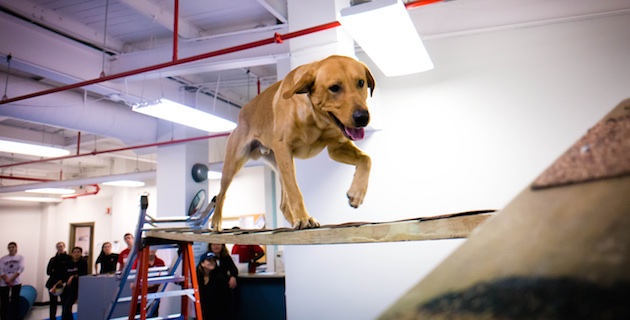 They climb ladders, run through tunnels and play hide-and-seek in the snow. They also go for a dip in the pool and get a pilates workout.
They climb ladders, run through tunnels and play hide-and-seek in the snow. They also go for a dip in the pool and get a pilates workout.Puppies learning to become search and rescue dogs will someday have very serious jobs. But when it comes to their training at the Penn Vet Working Dog Center (WDC) in Philadelphia, it's (almost) all fun and games.
Image: Penn Vet WDC three dogs on ladders
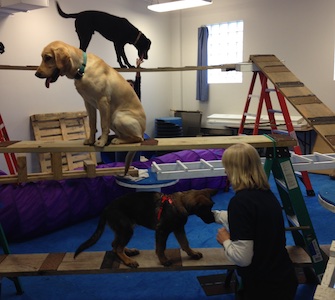 The dogs at the WDC are training to do a wide variety of detection jobs. Some will work in law enforcement, sniffing out explosives, fire accelerants and drugs; while others will participate in disaster recovery or have a medical focus, like detecting ovarian cancer or working as diabetic alert dogs. They learn through positive reinforcement and play - and fitness and obedience are keys to their success, too, says Dr. Cynthia Otto, a veterinarian who started the WDC and is the lead investigator in a long-term study on the health and behavior of detection dogs.
The dogs at the WDC are training to do a wide variety of detection jobs. Some will work in law enforcement, sniffing out explosives, fire accelerants and drugs; while others will participate in disaster recovery or have a medical focus, like detecting ovarian cancer or working as diabetic alert dogs. They learn through positive reinforcement and play - and fitness and obedience are keys to their success, too, says Dr. Cynthia Otto, a veterinarian who started the WDC and is the lead investigator in a long-term study on the health and behavior of detection dogs. Dr. Otto was inspired to start the center after taking care of the dogs who searched for survivors and later for remains at Ground Zero after the attacks of Sept. 11, 2001. As a tribute, the puppies are named for these canine heroes, as well as human rescuers and victims of 9/11.
Vetstreet talked with Dr. Otto to find out about the amazing ways the center trains puppies to do this vital search and rescue work.
Little Noses
Many of the dogs who've been trained at the WDC since it opened in 2012 were donated by breeders, and start classes when the puppies turn 8 weeks old - much earlier than most other working dog programs, which start at about a year old, Dr. Otto says. Recently, the center started breeding puppies, too.By raising its own litters, the researchers there are able to study the impact of the dogs' genetics - and follow their progress more closely from the outset.
When the puppies in its own litter were only three weeks old, the WDC team started introducing them to distinct scents in jars, including narcotics, arson and pepper. The researchers recorded the pups' reactions to the smells. Dr. Otto said the idea of introducing the puppies to the scents wasn't to figure out what they were interested in, but rather to stimulate the little guys' neural pathways.
“The ones that we have that are our own litters, we do all sorts of environmental work with them from day one, basically, and we encourage the breeders to do the same sorts of things,” Dr. Otto says.
Getting the Basics
When the WDC trainees first start classes at 8 weeks old, they're working on getting their “liberal arts degree,” explains Dr. Otto. “They get all of the foundational stuff for whatever it is that they might then show the most aptitude for. All of the dogs learn the basics of search, they all learn fitness, they all learn obedience, they all get exposed to different environmental stimuli. They all get the sort of basic curriculum.”The adorable students live with volunteer foster families who drop them off for class each day at 9 a.m. and pick them up at 5 p.m.
As they grow up, they begin to show their trainers their natural strengths and abilities. Their curriculum is then tailored to fit that interest, Dr. Otto says. The puppies who go on to get their “master's degree” in search and rescue often stand out in the crowd.
“Our search and rescue dogs are usually the ones who are a little bit more independent, they tend to be very confident - willing to just go anywhere, climb on anything, not have to constantly be looking back at the handler,” Dr. Otto said. They'll need that attitude on the job.
“We tend to let the dogs tell us where they're going to be most successful,” she said. “Some of them tell us when they're 8 or 10 weeks old - we're like 'whoa, this one is so clearly going in that direction.' And then, some change career paths, they change majors,” she says with a laugh.
Dog in a Box
Image: Working Dog Center - Dog in a Box
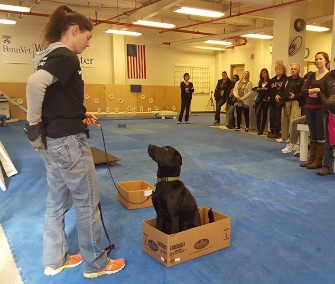 The dogs' training works in a progression, building upon what they've learned. The trainers keep it fun for the puppies. Some of the concepts they need to learn aren't things you've likely given a lot of thought to - and neither has the dog. Case in point: how to maneuver their back ends.
The dogs' training works in a progression, building upon what they've learned. The trainers keep it fun for the puppies. Some of the concepts they need to learn aren't things you've likely given a lot of thought to - and neither has the dog. Case in point: how to maneuver their back ends.“Dogs in general have really lousy backend awareness, so we have to build the concept that they have back feet and that they know what to do with their back feet and that they can control their back feet,” Dr. Otto says. “Most dogs have no clue. They just kind of ram forward and everything before them is in the world and everything behind them is just tagging along.”
One key to teaching the dogs how to control their individual legs is a game called “dog in a box.” The dogs are encouraged to explore a cardboard box, and to try climbing into it.
“A lot of dogs will climb in it with their front feet and then they get stuck. So it's a matter of learning that they actually can pick up their back feet, one at a time and put them in the box. When they're in the box it's like, 'let's party!' We have good fun with that,” Dr. Otto says.
Eventually they'll work on obstacle courses and even learn to climb ladders. “When they're walking on a ladder they have to step one foot then the other, then one foot then the other,” so knowing how to manipulate each individual foot is key.
The dogs also have to be nimble to work their way through wreckage at a disaster scene, so they're introduced to many types of surfaces to walk on. “Our puppies will have puppy agility, which means that we put all kinds of silly things on the floor - maybe metal grates, we have a kids' plastic slide, we have some wobbly things that they step on, and we just have them walk around on that and that's just building confidence,” Dr. Otto says.
Hide and Seek
Naturally, the ultimate game for a search and rescue dog in training is hide-and-seek, or “puppy runaways.”“You have a puppy and you have a toy that they think is really exciting, and one person is holding the puppy and another person has the toy,” Dr. Otto explains. “They show the puppy the toy and they get the dog excited like, 'Oh my gosh, that's my toy!' They run and they sort of duck behind something super easy -like maybe a barrier of some sort or a desk - and the puppy gets to watch where the person went, so they run and chase the toy and try and find where they went, and when they do, woo hoo! It's a big party and we play.”
Gradually this game gets harder for the pup. The person will hide in a place that's not as obvious. “They start to learn that they have to use their nose, and they start to smell because they can't see where the person went, and so that keeps building up and the environment gets more challenging,” Dr. Otto says.
There are usually several people watching, so the dogs quickly learn that they have to find the specific person who's the source of the reward - not just any person who's hidden.
“We really don't understand exactly how the dog figures all this out, but they do. It's really cool,” Dr. Otto says. “It's really important that they don't know who is hidden because in a disaster situation, we don't know who's missing.”
Exercise and Obedience
Image: WDC dog on tires
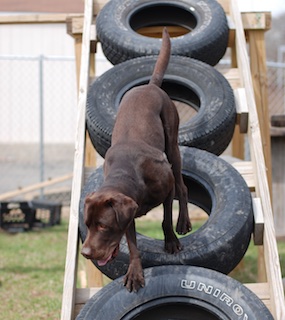 As you might imagine, all of this work means search and rescue dogs need to be in tip-top physical shape, too - and they require the obedience to work offleash in difficult locations.
As you might imagine, all of this work means search and rescue dogs need to be in tip-top physical shape, too - and they require the obedience to work offleash in difficult locations. The WDC prepares them for physical challenges and works to prevent injuries by helping them develop core strength like a gymnast.
“We do a lot of puppy pilates, core strength building exercises, flexibility, balance - we have a whole fitness program we call Fit to Work that we teach them, and all of our dogs have regular fitness sessions,” Dr. Otto says.
One of the fun parts for the dogs is swimming, which is another way for them to build their core strength. When they get a bit older, they work on stamina and endurance.
Obedience training is another important piece of the puzzle in the puppies' liberal arts and masters degrees. The dogs need to be able to follow instructions and stop or turn on a dime for their safety.
Once they are 18 months old, they're eligible to get their national certification.
Training Never Ends
So far, eight search and rescue dogs have graduated from the WDC, including some who are trained to find human remains.A few of the dogs serve on multiple disaster response teams, at the national and local levels. One of the graduates worked at the scene of the May 2015 Amtrak crash in Philadelphia that killed eight people and injured hundreds. But the others - luckily, Dr. Otto points out - haven't yet had the opportunity to be deployed to a major disaster.
While some dogs graduate from the WDC and start daily jobs working for the TSA or doing police work, for search and rescue dogs, their job is to continue to train - just in case.
“They train, and they train and they train and they train - they train 20 hours a week, every other weekend sometimes,” says Dr. Otto. “It's really an intense commitment by these handlers, and a lot of these handlers, this is their volunteer time - they don't get paid unless it's a deployment. These are really dedicated and committed folks."
But as long as the training remains a big game, these dogs will continue to love every minute of it.
More on Vetstreet:
Friday, May 6, 2016
You know the value that preventive care brings to your patients, but perhaps you're not certain how you can focus your efforts to deliver the best preventive care possible. The AVMA and the American Animal Hospital Association collaborated to develop … read more >
Thursday, May 5, 2016
Remember what it felt like when you were looking for your first job and had no idea what kind of salary was reasonable to expect? The AVMA has released a new tool to help veterinary students and new graduates develop … read more >
Wednesday, May 4, 2016
Life on a farm has changed over the last several decades. When I was young farm life created a community where every member had a role and every member was cared for throughout their normal life. But as time progressed … read more >
Monday, May 2, 2016
Dr. John de Jong, chair of the AVMA Board of Directors, addressed members of the House Energy and Commerce Committee's Commerce, Manufacturing and Trade Subcommittee Friday during a hearing about the pet medication industry. The hearing was live-streamed, and a recorded … read more >
Why is the AVMA advocating for this? The AVMA with guidance by its Aquatic Veterinary Medicine Committee wants to bridge a critical gap in the regulations and better protect, promote, and advance health and welfare of the farmed aquatic animals … read more >
Subscribe to:
Posts
(Atom)